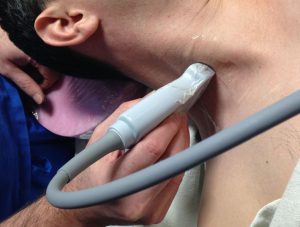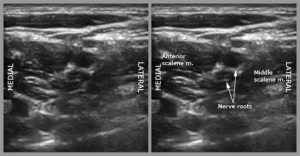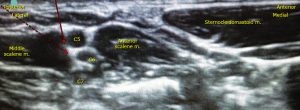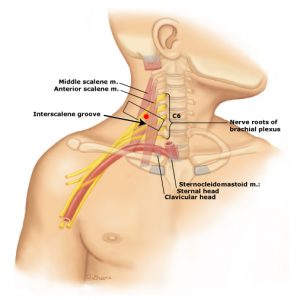Try an interscalene block! It anesthetizes C5-7 and is used in shoulder surgery- surely that is good enough for a measly little reduction. Studies in the ED have shown decreased time in the ED and good anesthesia for shoulder reduction.
Here is how:
- Place patient in supine position
- Using the linear ultrasound probe oriented like this:

- Identify the subclavian artery
- The brachial plexus looks like a “bundle of grapes” lateral the the subclavian artery
- Trace the brachial plexus superior with the transducer horizonal
- At the C6 level you can see the nerve roots within the interscalene groove with transducer in a vertical position

- Insert needle and inject anesthetic (12-30mL)

- You should see anesthetic spread surrounding the nerve roots
Complications to know about
- phrenic nerve block – causing hemi diaphragmatic paralysis
- horners syndrome
- pneumothorax
Want to watch a video?
Want to read more?
Blaivas M. et al. Ultrasound-guided interscalene block for shoulder dislocation reduction in the ED. Am J Emerg Med. 2006;24(3):293.
Blaivas M. et al. A prospective comparison of procedural sedation and ultrasound-guided interscalene nerve block for shoulder reduction in the emergency department. Acad Emerg Med. 2011;18(9):922. Epub 2011 Aug 30.
Raeyat D et al. Ultrasound-guided interscalene nerve block vs procedural sedation by propofol and fentanyl for anterior shoulder dislocations. Am J Emerg Med. 2017;35(10):1435. Epub 2017 Apr 14.

